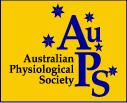

|
| Sunday 30th November 2014 | |||||||||||||||||||||||||||
| Rm 348 | Rm 358 | Rm 360 | |||||||||||||||||||||||||
| 14:00 |
Science Communication in Physiology Education
Education workshop Chair: Kay Colthorpe
|
||||||||||||||||||||||||||
| 14:30 | |||||||||||||||||||||||||||
| 15:00 | |||||||||||||||||||||||||||
| 15:30 | |||||||||||||||||||||||||||
| 16:00 |
Registration
Location: Lecture theatre foyer Lecture theatre foyer |
||||||||||||||||||||||||||
| 16:30 | |||||||||||||||||||||||||||
| 17:00 | |||||||||||||||||||||||||||
| 17:30 |
Welcome and AuPS Invited Lecture
Chair: Graham Lamb
|
||||||||||||||||||||||||||
| 18:00 | |||||||||||||||||||||||||||
| 18:30 | |||||||||||||||||||||||||||
|
Welcome reception
Location: Advanced Engineering Building Level 6 |
|||||||||||||||||||||||||||
| 19:00 | |||||||||||||||||||||||||||
| 19:30 | |||||||||||||||||||||||||||
| 20:00 | |||||||||||||||||||||||||||
| 20:30 | |||||||||||||||||||||||||||
| 21:00 | Buses to Southbank and Queen St Mall | ||||||||||||||||||||||||||
| Monday 1st December 2014 | |||||||||||||||||||||||||||||||||||||||||||||||||||||||||||||||||||||||||||||||||||||||||||||||||||||||||
| Rm 348 | Rm 358 | Rm 360 | |||||||||||||||||||||||||||||||||||||||||||||||||||||||||||||||||||||||||||||||||||||||||||||||||||||||
| 08:30 |
Symposium: Genetics influences on skeletal muscle physiology and athletic performance Chair: David Bishop
|
Symposium: Teaching and learning within undergraduate research experiences in physiology
Chairs: Andrea Bugarcic & Louise Ainscough
|
Symposium: Exocytosis Chair: Peter Thorn
|
||||||||||||||||||||||||||||||||||||||||||||||||||||||||||||||||||||||||||||||||||||||||||||||||||||||
| 09:00 | |||||||||||||||||||||||||||||||||||||||||||||||||||||||||||||||||||||||||||||||||||||||||||||||||||||||||
| 09:30 | |||||||||||||||||||||||||||||||||||||||||||||||||||||||||||||||||||||||||||||||||||||||||||||||||||||||||
| 10:00 | |||||||||||||||||||||||||||||||||||||||||||||||||||||||||||||||||||||||||||||||||||||||||||||||||||||||||
| 10:30 |
Morning Tea
Location: Chemistry Podium |
||||||||||||||||||||||||||||||||||||||||||||||||||||||||||||||||||||||||||||||||||||||||||||||||||||||||
| 11:00 |
Symposium: Ion channels and pathophysiological changes in ionic regulation Chairs: Peter Thorn & Bradley Launikonis
|
Symposium: Interaction of metabolic balance and growth hormone Chair: Chen Chen
|
|||||||||||||||||||||||||||||||||||||||||||||||||||||||||||||||||||||||||||||||||||||||||||||||||||||||
| 11:30 | |||||||||||||||||||||||||||||||||||||||||||||||||||||||||||||||||||||||||||||||||||||||||||||||||||||||||
| 12:00 | |||||||||||||||||||||||||||||||||||||||||||||||||||||||||||||||||||||||||||||||||||||||||||||||||||||||||
| 12:30 | |||||||||||||||||||||||||||||||||||||||||||||||||||||||||||||||||||||||||||||||||||||||||||||||||||||||||
| 13:00 |
Lunch
Location: Chemistry Podium |
||||||||||||||||||||||||||||||||||||||||||||||||||||||||||||||||||||||||||||||||||||||||||||||||||||||||
| 13:30 |
Posters
Location: Chemistry Podium Odd board authors in attendance.
|
||||||||||||||||||||||||||||||||||||||||||||||||||||||||||||||||||||||||||||||||||||||||||||||||||||||||
| 14:00 | |||||||||||||||||||||||||||||||||||||||||||||||||||||||||||||||||||||||||||||||||||||||||||||||||||||||||
| 14:30 |
Michael Roberts Lecture
Chair: David Saint
|
||||||||||||||||||||||||||||||||||||||||||||||||||||||||||||||||||||||||||||||||||||||||||||||||||||||||
| 15:00 |
Afternoon Tea
Location: Chemistry Podium |
||||||||||||||||||||||||||||||||||||||||||||||||||||||||||||||||||||||||||||||||||||||||||||||||||||||||
| 15:30 |
Symposium: Cardiac metabolic stressors and sensors Chair: Lea Delbridge
|
Symposium: Placental development and function: effects of maternal perturbations during pregnancy Chairs: Paul Dawson & Karen Moritz
|
Free Communications: Exercise Physiology
Chairs: Tony Bakker & Mark Hargreaves
|
||||||||||||||||||||||||||||||||||||||||||||||||||||||||||||||||||||||||||||||||||||||||||||||||||||||
| 16:00 | |||||||||||||||||||||||||||||||||||||||||||||||||||||||||||||||||||||||||||||||||||||||||||||||||||||||||
| 16:30 | |||||||||||||||||||||||||||||||||||||||||||||||||||||||||||||||||||||||||||||||||||||||||||||||||||||||||
| 17:00 | |||||||||||||||||||||||||||||||||||||||||||||||||||||||||||||||||||||||||||||||||||||||||||||||||||||||||
| 17:30 | |||||||||||||||||||||||||||||||||||||||||||||||||||||||||||||||||||||||||||||||||||||||||||||||||||||||||
| 17:45 & 18:00: 2 Buses to Southbank and Customs House | |||||||||||||||||||||||||||||||||||||||||||||||||||||||||||||||||||||||||||||||||||||||||||||||||||||||||
| 18:00 | |||||||||||||||||||||||||||||||||||||||||||||||||||||||||||||||||||||||||||||||||||||||||||||||||||||||||
| 18:30 |
18:30-20:30 Student/ECR Mixer
Location: Next Door Kitchen & Bar, Southbank |
||||||||||||||||||||||||||||||||||||||||||||||||||||||||||||||||||||||||||||||||||||||||||||||||||||||||
| 19:00 | |||||||||||||||||||||||||||||||||||||||||||||||||||||||||||||||||||||||||||||||||||||||||||||||||||||||||
| 19:30 | |||||||||||||||||||||||||||||||||||||||||||||||||||||||||||||||||||||||||||||||||||||||||||||||||||||||||
| 20:00 | |||||||||||||||||||||||||||||||||||||||||||||||||||||||||||||||||||||||||||||||||||||||||||||||||||||||||
| Tuesday 2nd December 2014 | ||||||||||||||||||||||||||||||||||||||||||||||||||||||
| Rm 348 | Rm 358 | Rm 360 | ||||||||||||||||||||||||||||||||||||||||||||||||||||
| 08:30 |
Invited Lecture
Chair: David Allen
|
|||||||||||||||||||||||||||||||||||||||||||||||||||||
| 09:00 | ||||||||||||||||||||||||||||||||||||||||||||||||||||||
| 09:30 |
Free Communications: Skeletal Muscle Physiology
Chairs: Enzo Porrello & Tanya Cully
|
Free Communications: Reproduction
Chairs: David Simmons & Karen Gibson
|
Free Communications: Channels and Nervous System
Chairs: David Adams & Helena Parkinson
|
|||||||||||||||||||||||||||||||||||||||||||||||||||
| 10:00 | ||||||||||||||||||||||||||||||||||||||||||||||||||||||
| 10:30 | ||||||||||||||||||||||||||||||||||||||||||||||||||||||
| 11:00 |
Morning Tea
Location: Chemistry Podium |
|||||||||||||||||||||||||||||||||||||||||||||||||||||
| 11:30 |
Symposium: Can we age well? Chairs: Robyn Murphy & Peter Houweling
|
Free Communications: Endocrinology, Diabetes and Cancer
Chairs: Damien Keating & Frederik Steyn
|
||||||||||||||||||||||||||||||||||||||||||||||||||||
| 12:00 | ||||||||||||||||||||||||||||||||||||||||||||||||||||||
| 12:30 | ||||||||||||||||||||||||||||||||||||||||||||||||||||||
| 13:00 | ||||||||||||||||||||||||||||||||||||||||||||||||||||||
| 13:30 |
Lunch
Location: Chemistry Podium |
|||||||||||||||||||||||||||||||||||||||||||||||||||||
| 14:00 |
Posters
See Monday for list. Even board authors in attendance. |
|||||||||||||||||||||||||||||||||||||||||||||||||||||
| 14:30 |
14:30 Student/ECR & Professors Talk
Jamie Vandenberg and Mary Wlodek will co-head the open discussion |
|||||||||||||||||||||||||||||||||||||||||||||||||||||
| 15:00 |
Afternoon Tea
Location: Chemistry Podium |
|||||||||||||||||||||||||||||||||||||||||||||||||||||
| 15:30 |
Symposium: Frontiers of molecular mechanisms of ligand recognition and activation of receptor channels Chairs: Yoshihiro Kubo & Trevor Lewis
|
Symposium: Early life environment as an indicator of health; outcomes and prevention Chairs: Deanne Hryciw & Glenn Wadley
|
Free Communications: Skeletal Muscle Signalling
Chairs: Nicole Stupka & David Bishop
|
|||||||||||||||||||||||||||||||||||||||||||||||||||
| 16:00 | ||||||||||||||||||||||||||||||||||||||||||||||||||||||
| 16:30 | ||||||||||||||||||||||||||||||||||||||||||||||||||||||
| 17:00 | ||||||||||||||||||||||||||||||||||||||||||||||||||||||
| 17:30 | ||||||||||||||||||||||||||||||||||||||||||||||||||||||
| 17:45 & 18:00: 2 Buses to Southbank and Customs House | ||||||||||||||||||||||||||||||||||||||||||||||||||||||
| 18:00 | ||||||||||||||||||||||||||||||||||||||||||||||||||||||
| 18:30 | ||||||||||||||||||||||||||||||||||||||||||||||||||||||
| 19:00 | ||||||||||||||||||||||||||||||||||||||||||||||||||||||
| 19:30 |
19:30 - midnight - Conference Dinner
Location: Customs House |
|||||||||||||||||||||||||||||||||||||||||||||||||||||
| 20:00 | ||||||||||||||||||||||||||||||||||||||||||||||||||||||
| 20:30 | ||||||||||||||||||||||||||||||||||||||||||||||||||||||
| 21:00 | ||||||||||||||||||||||||||||||||||||||||||||||||||||||
| 21:30 | ||||||||||||||||||||||||||||||||||||||||||||||||||||||
| 22:00 | ||||||||||||||||||||||||||||||||||||||||||||||||||||||
| 22:30 | ||||||||||||||||||||||||||||||||||||||||||||||||||||||
| 23:00 | ||||||||||||||||||||||||||||||||||||||||||||||||||||||
| 23:30 | ||||||||||||||||||||||||||||||||||||||||||||||||||||||
| Wednesday 3rd December 2014 | |||||||||||||||||||||||||||||||||||||||||||||||||||
| Rm 348 | Rm 358 | Rm 360 | |||||||||||||||||||||||||||||||||||||||||||||||||
| 09:00 |
Invited Lecture
Chair: David Adams
|
||||||||||||||||||||||||||||||||||||||||||||||||||
| 09:30 | |||||||||||||||||||||||||||||||||||||||||||||||||||
| 10:00 |
Morning Tea
Location: Chemistry Podium |
||||||||||||||||||||||||||||||||||||||||||||||||||
| 10:30 |
Symposium: Cardiomyocyte Ca2+ and Na+ signalling - new mechanistic insights Chairs: James Bell & David Saint
|
Symposium: New insights into exercise and insulin sensitivity Chair: Glenn McConnell
|
|||||||||||||||||||||||||||||||||||||||||||||||||
| 11:00 | |||||||||||||||||||||||||||||||||||||||||||||||||||
| 11:30 | |||||||||||||||||||||||||||||||||||||||||||||||||||
| 12:00 | |||||||||||||||||||||||||||||||||||||||||||||||||||
| 12:30 |
Lunch
Location: Chemistry Podium |
||||||||||||||||||||||||||||||||||||||||||||||||||
| 13:00 | 13:00 AGM | ||||||||||||||||||||||||||||||||||||||||||||||||||
| 13:30 | |||||||||||||||||||||||||||||||||||||||||||||||||||
| 14:00 |
Symposium: Mechanisms and treatments for muscle wasting Chairs: Kate Murphy & Gordon Lynch
|
Free Communications: Cardiac Physiology
Chairs: David Allen & Melissa Reichelt
|
Free Communications: Exercise and Muscle Signalling
Chairs: Torie Foletta & Robyn Murphy
|
||||||||||||||||||||||||||||||||||||||||||||||||
| 14:30 | |||||||||||||||||||||||||||||||||||||||||||||||||||
| 15:00 | |||||||||||||||||||||||||||||||||||||||||||||||||||
| 15:30 | |||||||||||||||||||||||||||||||||||||||||||||||||||
Administration access - requires authorisation
|
Copyright © 1996-2025 AuPS Inc. Last updated 10 December 2018.
Comments or questions on the content of this site should be directed to the Secretary, AuPS. Technical problems should be referred to the Webmaster Privacy Policy |

|